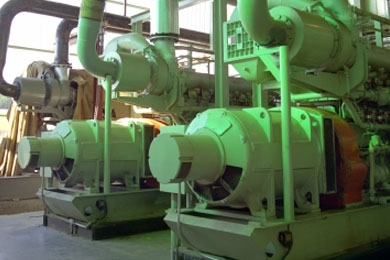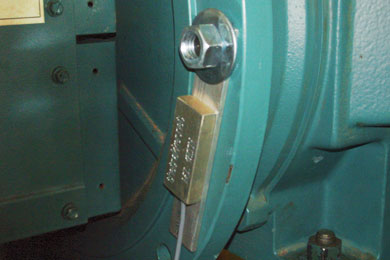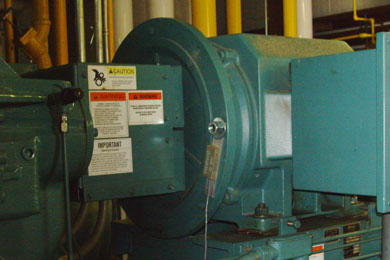Vibration Analysis and related data acquisition for industrial compressor applications
Ammonia screw and reciprocating compressors are a vital part of facilities running refrigerants for frozen food processing or commercial ice production, where cooling load applications are high. The compressors are also utilized in cooling storage facilities. If the loss of a compressor occurs, production runs can be spoiled with very expensive consequences.
The Traditional Maintenance model for Running Compressors
Some screw compressors have a history of operating up to 150k hours between re-builds. A glitch in a bearing, screw surface, or slide can result in a failure of the compressor. Failures in ammonia compressors often correlate with the loss of some amount of the ammonia refrigerant, resulting in fines given for the creation of occupational hazard. These fines can be significantly higher than several rebuilds would cost. Therefore, most companies will contract a service vendor that will come in annually, semi-annually, quarterly, or even monthly to conduct vibration analysis and equipment review. Most rebuilds are typically done every 25,000 to 35,000 operating hours depending on manufacturer model and machine age.
Getting good data with Vibration analysis
Something that we have discovered is that there are variances in vibration signal based on the production load – this has been traditionally overlooked by conventional predictive maintenance programs.
The problem with periodic examination of the compressors is the fact that the vibration signal for a specific compressor that is under a 90% load is significantly different than the vibration signal of the same compressor when it is under a 70%, 60%, 50% or lower load. The service company, if it is a quarterly inspection agreement will be there during the winter (perhaps on a cold or cool day) and during the summer (perhaps on a blisteringly hot day) and just the changing circumstances of temperature or of changing production load will alter the operating load that is encountered during the test phase – which will alter the vibration/temperature signature of the equipment. There are just not enough controls placed on the empirical data.
In order to get true comparative data, one needs to log the amp draw of the compressor motor, the pressure at the inlet and outlet of the refrigerant gas (generally a liquid on the input), the position of the slide and the vibration of the motor, compressor front and rear bearings. These six data points and the flow rate of the ammonia must be logged simultaneously and then the data from day to day, week to week, and month to month analyzed by a program that compares data during the same operating conditions.
Example:
The system can compare all of the data when the Slide is 90% engaged:
- Amp draw
- Inlet and outlet pressure (could be temperature as the enthalpy tables are constructed for either)
- Vibration signatures of the Motor and all bearings
- What is the flow (gal or Lbs) of refrigerant (with the flow data – one can determine the exact cost to produce each ton of refrigeration)
A Company that follows the procedure outlined above can safely delay automatic rebuilds until the data indicates the need for service. This can provide cost savings because the rebuilds are very expensive and can also be time consuming.
Intelligently Plan Maintenance Schedules: An Example
A company with seven screw compressors, consisting of three low and three high with a swing in the middle. They may find two units that need to be rebuilt at the end of 25,000 hours, three that will run to 45,000 hours, and one that operates for 60,000 hours, and another that goes much longer. The next cycle may indicate that the two short cycled compressors on the first rebuild will go 50,000 hours on the second cycle and one of the original 45,000 hour compressors must be rebuilt at the end of 20,000 hours, or sooner than simple predictive maintenance programs would otherwise indicate.
The fact of the matter is that no two pieces of equipment are identical, and no two rebuilds will ever be the same.
Rebuilding according to a schedule is convenient – but it is not fiscally prudent
- Why rebuild or replace a piece of equipment until it is time?
- Why change a liquid filter until it is spent?
- Why change an air filter until it is at the point of saturation?



-
Example: Chiller Temperature Control with the OWL Board
An analog output signal could turn a chiller on at 60% when the temperature reaches 72.00° F and increase the operational percentage by 1% for each .02 degrees that the temperature increases. It also allows for the reduction in operating output in a reverse manner as the temperature starts to cool as night approaches. The division is actually .09% so that for fine controls one might increase the output of a device by a tenth of a percentage point as required.
-
Utilize your compressor units more precisely
Valuable operating information is provided by the system. Using the various points of data acquisition, one can easily have the computer determine the most efficient setup of lead & lag compressors. In an example of 3 compressors, High-side compressor #2 may be more efficient at 90% load than either #1 or #3, but #3 may be more efficient at a 70% load than the others. The TRAKKER system will provide the empirical data required to determine how each compressor performs under various load conditions and each compressor's operational relationship to sister devices, which will determine how and when to use each compressor, using the data that is polled every 200 milliseconds.